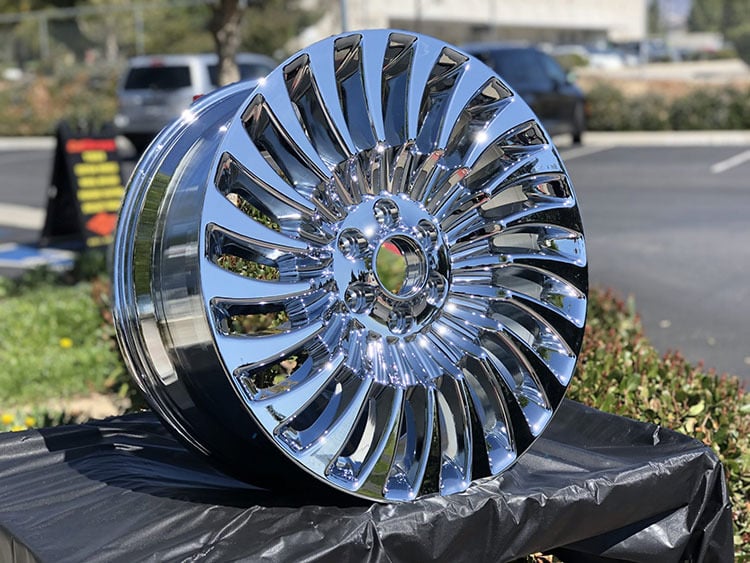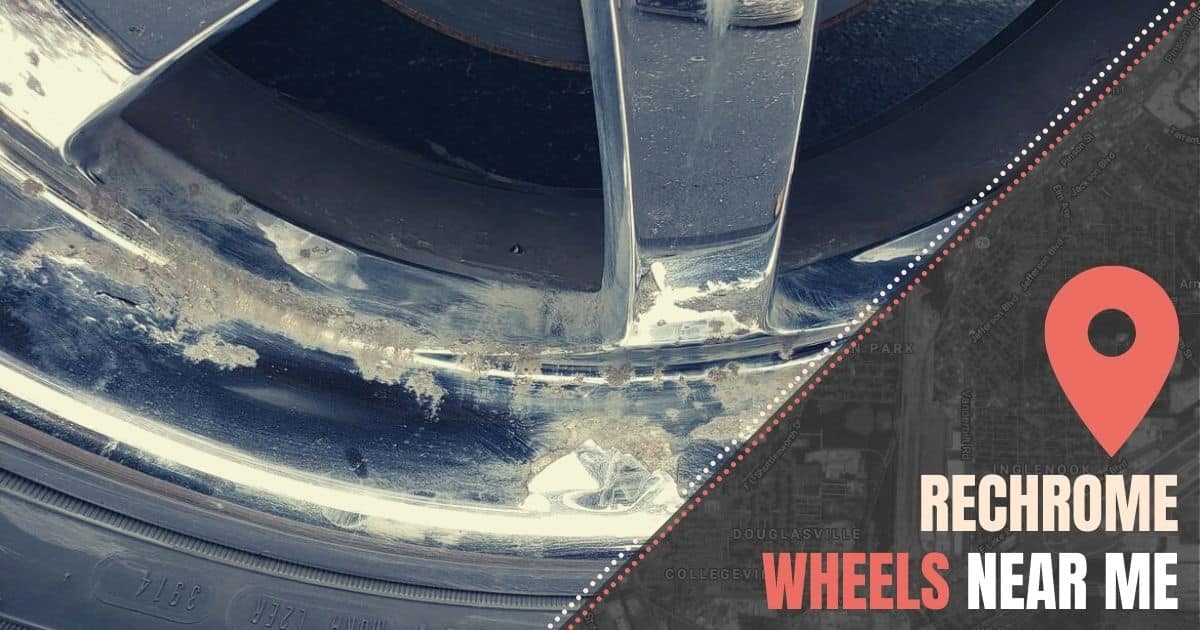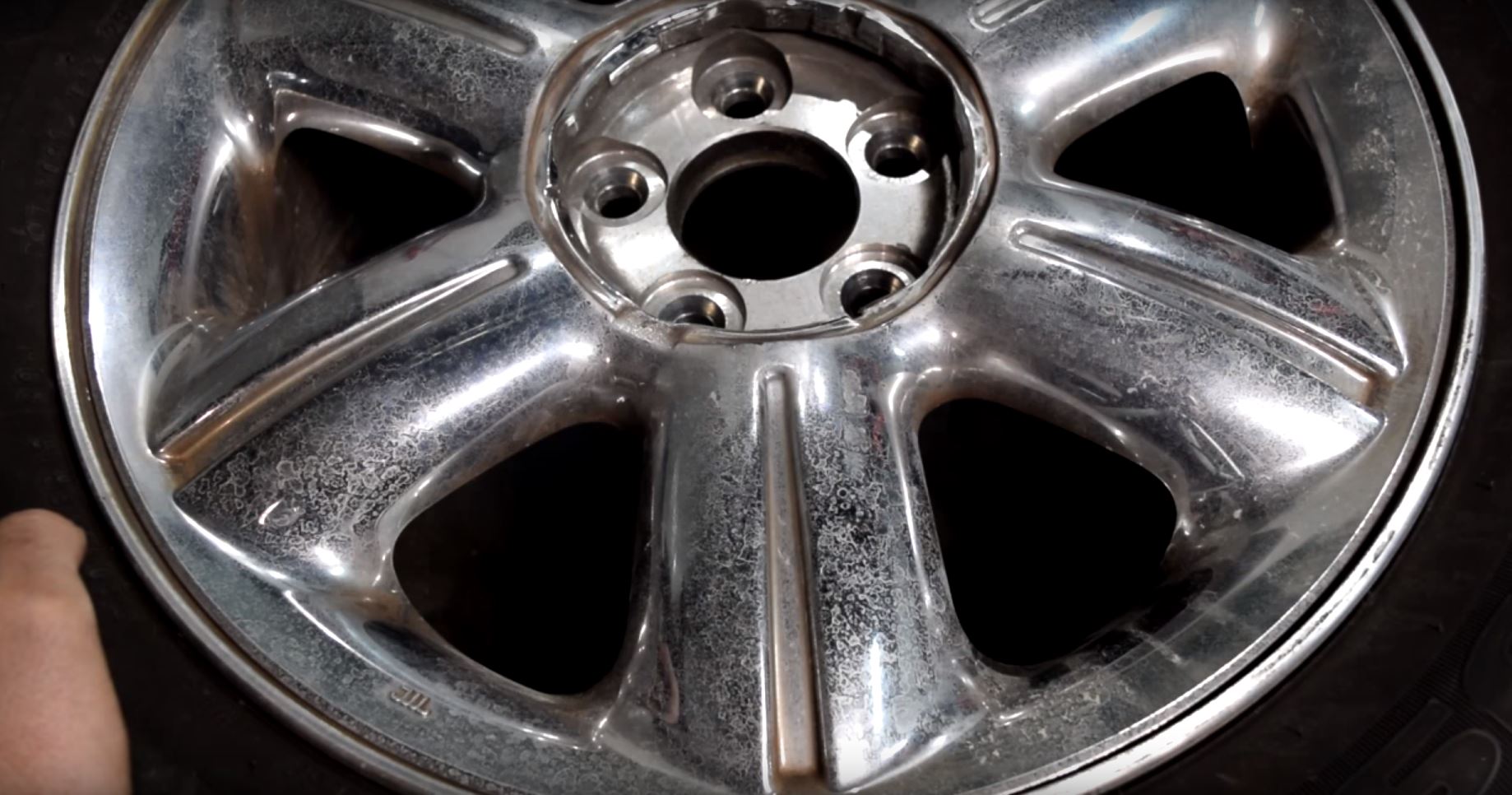How to rechrome wheels takes center stage, inviting readers into a world of gleaming metal and automotive restoration. Chrome plating, a process that adds a thin layer of chromium to a metal surface, is a popular choice for wheels, transforming their appearance and enhancing their durability. This guide delves into the intricacies of rechroming wheels, providing a comprehensive understanding of the process, its benefits, and the factors to consider when embarking on this endeavor.
From understanding the different types of chrome plating to preparing wheels for the process, we cover every step in detail. We explore the various methods used for chrome plating, analyze their advantages and disadvantages, and offer insights into the cost implications. We also discuss the importance of maintaining chrome wheels and provide tips for preserving their luster and longevity. Ultimately, this guide aims to equip readers with the knowledge and understanding necessary to make informed decisions about rechroming their wheels.
Understanding Chrome Plating

Chrome plating is a process that involves depositing a thin layer of chromium onto a substrate material, typically metal. This process enhances the substrate’s appearance, durability, and resistance to corrosion. Chrome plating is widely used in various industries, including automotive, aerospace, and manufacturing, due to its unique properties.
The Process of Chrome Plating
Chrome plating is a complex process that involves several steps, each contributing to the final finish. The process typically starts with preparing the substrate by cleaning and polishing it to remove any impurities or imperfections. This step ensures that the chrome plating adheres properly to the substrate. The prepared substrate is then immersed in an electrolytic bath containing chromic acid and sulfuric acid.
An electric current is passed through the bath, causing chromium ions to be deposited onto the substrate. The thickness of the chrome plating can be controlled by adjusting the current density and plating time.
Benefits of Chrome Plating for Wheels
Chrome plating offers numerous advantages for wheels, making them a popular choice for both aesthetic and functional purposes.
- Durability: Chrome plating creates a hard, wear-resistant surface that can withstand scratches, abrasions, and other forms of damage. This makes chrome-plated wheels highly durable and capable of handling the rigors of everyday use.
- Corrosion Resistance: Chrome is highly resistant to corrosion, making chrome-plated wheels less susceptible to rust and oxidation. This is especially beneficial in environments where wheels are exposed to harsh weather conditions or road salt.
- Aesthetics: Chrome plating imparts a brilliant, mirror-like finish to wheels, enhancing their visual appeal. The shiny, reflective surface adds a touch of elegance and sophistication to any vehicle.
Types of Chrome Plating
Chrome plating is available in various types, each with its unique characteristics and applications.
- Hard Chrome: Hard chrome plating is known for its exceptional hardness and wear resistance. It is typically used in industrial applications where components are subjected to high levels of wear and tear. Hard chrome plating is not commonly used for wheels due to its high cost and the potential for cracking.
- Decorative Chrome: Decorative chrome plating is the most common type used for wheels. It is designed to provide a highly reflective, aesthetically pleasing finish. Decorative chrome plating is less expensive than hard chrome and is more suitable for automotive applications.
- Black Chrome: Black chrome plating offers a dark, matte finish that is both durable and visually appealing. It is often used for wheels that require a more subtle, understated look. Black chrome plating is typically achieved by adding a black oxide layer over the chrome plating.
Preparing Wheels for Chrome Plating

Chrome plating adheres best to a clean, smooth, and properly prepared surface. The quality of the plating depends heavily on the preparation process. Failing to remove contaminants, rust, or imperfections will result in a poor finish, and the chrome may even peel off over time.
Cleaning Wheels
Thorough cleaning is the first step in preparing wheels for chrome plating. This removes dirt, grease, grime, and other contaminants that can hinder the adhesion of the chrome plating. Here’s how to clean wheels for chrome plating:
- Remove the wheels from the vehicle. This allows for easier access to all surfaces of the wheel for cleaning.
- Use a degreaser or solvent to remove any oil, grease, or other contaminants. Apply the degreaser to the entire wheel surface, and scrub it with a brush or cloth. Pay special attention to the crevices and hard-to-reach areas.
- Rinse the wheels thoroughly with water. This removes the degreaser and any remaining contaminants.
- Dry the wheels completely. Use a clean cloth or air compressor to dry the wheels thoroughly.
Sanding Wheels
Sanding is essential to create a smooth surface for the chrome plating to adhere to. This involves removing any imperfections, such as scratches, dents, or rust, that may be present on the wheel. The goal is to create a uniform surface that will provide an even chrome finish.
- Use progressively finer grades of sandpaper. Start with a coarse-grit sandpaper to remove any deep scratches or dents. Then, use a medium-grit sandpaper to smooth out the surface. Finally, finish with a fine-grit sandpaper to create a smooth, polished surface.
- Sand in one direction. Sanding in the same direction will create a consistent surface. Avoid sanding in a circular motion, as this can create swirls and imperfections.
- Sand all surfaces evenly. Ensure that all surfaces of the wheel are sanded evenly. This will ensure that the chrome plating adheres evenly to the entire wheel.
- Inspect the wheel surface for any remaining imperfections. If necessary, repeat the sanding process until the surface is smooth and free of imperfections.
Masking Wheels
Masking is the process of covering areas of the wheel that you don’t want to be chrome plated. This includes areas like the valve stem, tire bead, and any other areas that need to be protected. Proper masking is crucial to ensure that the chrome plating only adheres to the desired areas.
- Use masking tape and paper. Apply masking tape to the areas that you don’t want to be chrome plated. Then, cover the taped areas with masking paper to prevent the chrome plating solution from reaching those areas.
- Ensure that the masking is secure. Make sure that the masking tape and paper are securely attached to the wheel. Any gaps or leaks can allow the chrome plating solution to reach areas that you don’t want to be plated.
- Inspect the masking for any gaps or leaks. Before proceeding with the chrome plating process, inspect the masking to ensure that it is complete and secure.
Chrome Plating Methods
Chrome plating is the process of applying a thin layer of chromium to a substrate, typically metal, to enhance its properties such as durability, corrosion resistance, and aesthetics. Several methods are used to achieve chrome plating, each with its advantages and disadvantages. This section explores the most common chrome plating methods, highlighting their unique features and suitability for different wheel types and applications.
Electroplating, How to rechrome wheels
Electroplating is the most widely used method for chrome plating. It involves immersing the substrate in an electrolytic bath containing chromium ions. An electric current is then passed through the bath, causing the chromium ions to deposit onto the substrate, forming a thin, uniform layer of chrome. Electroplating is a versatile technique that can be used to plate various metals, including steel, aluminum, and plastic.The process involves several steps:
- Cleaning: The substrate is thoroughly cleaned to remove any dirt, grease, or other contaminants that may interfere with the plating process.
- Pretreatment: The substrate is then pretreated to improve adhesion of the chrome layer. This may involve processes like etching, anodizing, or nickel plating.
- Electroplating: The substrate is immersed in an electrolytic bath containing chromium ions. A direct current is passed through the bath, causing chromium ions to deposit onto the substrate.
- Rinsing: After plating, the substrate is rinsed to remove any residual plating solution.
- Finishing: Finally, the plated substrate may be polished or buffed to achieve a desired finish.
Electroplating offers several advantages:
- High quality: Electroplating produces a smooth, uniform chrome layer with excellent adhesion and corrosion resistance.
- Versatility: It can be used to plate a wide range of metals and shapes.
- Cost-effective: Electroplating is a relatively inexpensive process compared to other methods.
However, electroplating also has some disadvantages:
- Limited thickness: Electroplated chrome layers are typically thin, which may limit their wear resistance.
- Environmental concerns: The plating process generates hazardous waste, requiring proper disposal.
- Time-consuming: Electroplating can be a time-consuming process, particularly for complex shapes.
Electroplating is an ideal choice for applications where a high-quality, thin chrome layer is required, such as decorative plating on car parts, furniture, and appliances.
Electroless Plating
Electroless plating is a chemical plating process that does not require an external electric current. Instead, the plating solution contains both chromium ions and a reducing agent. The reducing agent reacts with the chromium ions, causing them to deposit onto the substrate. Electroless plating is often used to deposit a thin layer of nickel on the substrate before applying the chrome layer.
This provides a more durable and corrosion-resistant finish.Electroless plating offers several advantages:
- Uniform plating: Electroless plating can produce a more uniform chrome layer than electroplating, particularly on complex shapes.
- Thicker layers: Electroless plating can deposit thicker chrome layers than electroplating, providing greater wear resistance.
- Improved adhesion: Electroless plating provides better adhesion of the chrome layer to the substrate.
However, electroless plating also has some disadvantages:
- Costly: Electroless plating is a more expensive process than electroplating.
- Limited substrate compatibility: Electroless plating is not suitable for all substrates.
- Less versatile: Electroless plating is less versatile than electroplating, with limited options for plating complex shapes.
Electroless plating is a good choice for applications where a thick, durable, and uniform chrome layer is required, such as on industrial equipment and machinery.
Physical Vapor Deposition (PVD)
Physical vapor deposition (PVD) is a vacuum coating process that involves vaporizing a target material, typically chromium, and depositing it onto the substrate. PVD is a relatively new technology that offers several advantages over traditional chrome plating methods.PVD involves several steps:
- Vacuum Chamber: The substrate is placed in a vacuum chamber, which is then evacuated to a very low pressure.
- Target Material: A target material, typically chromium, is placed in the chamber and bombarded with ions, causing it to vaporize.
- Deposition: The vaporized chromium atoms travel to the substrate and deposit onto its surface, forming a thin layer of chrome.
- Cooling: The substrate is then cooled to allow the chrome layer to solidify.
PVD offers several advantages:
- High quality: PVD produces a very thin, dense, and uniform chrome layer with excellent adhesion and corrosion resistance.
- Environmentally friendly: PVD is an environmentally friendly process that does not generate hazardous waste.
- Versatile: PVD can be used to deposit various materials, including chrome, titanium, and tungsten, onto a wide range of substrates.
However, PVD also has some disadvantages:
- Costly: PVD is a more expensive process than traditional chrome plating methods.
- Limited thickness: PVD can only deposit very thin chrome layers, which may limit their wear resistance.
- Complex process: PVD is a more complex process than traditional chrome plating methods, requiring specialized equipment and expertise.
PVD is a good choice for applications where a high-quality, thin chrome layer is required, such as on high-performance automotive parts, aerospace components, and medical devices.
Maintaining Chrome Wheels

Chrome wheels, with their gleaming finish, are a beautiful addition to any vehicle. But maintaining their shine and protecting them from damage requires consistent care. Neglecting their upkeep can lead to corrosion, scratches, and a dull appearance. Regular cleaning and polishing are essential to ensure their longevity and prevent premature deterioration.
Cleaning Chrome Wheels
Regular cleaning is the cornerstone of chrome wheel maintenance. Dirt, grime, brake dust, and road salt can all damage the chrome finish. Here’s a step-by-step guide for cleaning chrome wheels:
- Start with a cool wheel: Never clean hot wheels, as the sudden temperature change can cause the chrome to crack or peel.
- Use a dedicated chrome cleaner: Avoid harsh chemicals, abrasives, or acidic cleaners that can damage the chrome finish. Look for a cleaner specifically designed for chrome.
- Apply the cleaner: Spray or apply the cleaner evenly to the entire wheel, including the spokes and the lip.
- Scrub gently: Use a soft-bristled brush or microfiber cloth to remove dirt and grime. Avoid using abrasive sponges or scrubbers that can scratch the chrome.
- Rinse thoroughly: Rinse the wheels with clean water to remove all traces of the cleaner and dirt.
- Dry completely: Dry the wheels with a clean microfiber cloth or towel. Leave no water droplets on the surface, as they can leave water spots.
Polishing Chrome Wheels
Polishing chrome wheels is a crucial step in maintaining their shine. Over time, chrome can become dull due to oxidation and exposure to the elements. Polishing helps restore the shine and protect the chrome from further damage.
- Choose a chrome polish: Use a polish specifically designed for chrome. Avoid using general-purpose polishes or waxes that can leave a residue on the chrome.
- Apply the polish: Apply a small amount of polish to a microfiber cloth. Work the polish into the chrome in a circular motion, applying gentle pressure.
- Buff the polish: Once the polish has been applied, use a clean microfiber cloth to buff the chrome to a shine. Buff in a circular motion, working from the center of the wheel outward.
- Repeat as needed: The frequency of polishing depends on the condition of the chrome and the amount of exposure to the elements. Generally, polishing every few months is sufficient.
Addressing Common Issues
Even with regular cleaning and polishing, chrome wheels can experience common issues. Understanding how to address these issues can help prevent further damage and maintain the appearance of your wheels.
Pitting
Pitting is a common issue with chrome wheels, caused by corrosion. It appears as small holes or indentations in the chrome surface.
- Preventative measures: Regular cleaning and polishing can help prevent pitting. Immediately address any scratches or damage to the chrome surface, as these can lead to pitting.
- Professional repair: Pitting can be difficult to remove at home. If pitting is present, it’s best to consult a professional chrome plating shop for repair.
Fading
Chrome can fade over time, especially with prolonged exposure to sunlight and the elements. This can cause the chrome to lose its shine and appear dull.
- Preventative measures: Regular cleaning and polishing can help prevent fading. Consider using a chrome sealant to protect the chrome from UV rays and the elements.
- Professional re-chroming: If the chrome has faded significantly, it may be necessary to have the wheels re-chromed by a professional.
Peeling
Peeling occurs when the chrome layer separates from the underlying metal. This can be caused by damage, corrosion, or improper cleaning.
- Preventative measures: Regular cleaning and polishing can help prevent peeling. Avoid using harsh chemicals or abrasives on the chrome.
- Professional repair: If peeling is present, it’s best to consult a professional chrome plating shop for repair.
Rechroming wheels is a process that requires meticulous attention to detail and a thorough understanding of the intricacies involved. While DIY options exist, seeking professional assistance is often the most reliable and efficient approach. By carefully considering the factors Artikeld in this guide, you can make an informed decision about whether rechroming your wheels is the right choice for you and, if so, how to achieve the desired results.
Whether you’re seeking to restore your classic car’s wheels to their former glory or simply enhance the look and durability of your modern vehicle, rechroming offers a compelling solution.
Popular Questions: How To Rechrome Wheels
What are the signs that my wheels need rechroming?
Signs that your wheels may need rechroming include peeling, pitting, fading, or excessive corrosion. If the chrome layer is compromised, it may be time to consider rechroming.
Is rechroming a permanent solution?
While rechroming can significantly extend the life of your wheels, it is not a permanent solution. Over time, the chrome layer can still wear down or become damaged, potentially requiring rechroming again.
Can I rechrome wheels myself?
While DIY chrome plating is possible, it is a complex and potentially dangerous process that requires specialized equipment and expertise. It is generally recommended to seek professional services for rechroming.
What is the difference between hard chrome and decorative chrome?
Hard chrome is a thicker, more durable type of plating used for industrial applications. Decorative chrome, on the other hand, is thinner and focuses on aesthetics, commonly used for automotive parts.